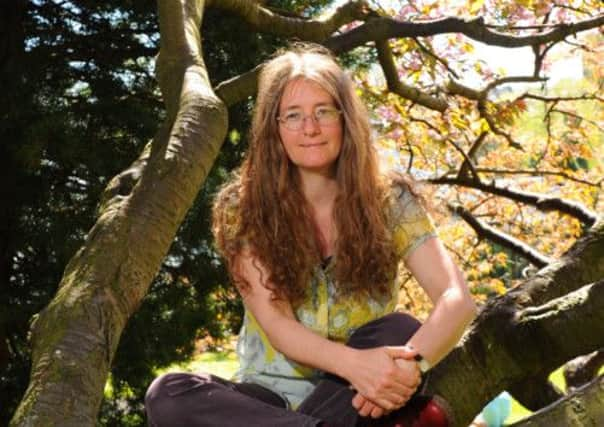Roger Cox talks to poet Mandy Haggith


It’s always fun when interviewees go deliberately off-message – even more so when they end up machine-gunning sacred cows as a result. Sitting in a many-windowed conference room at Edinburgh’s Royal Botanic Garden, I’m talking to the poet and environmental activist Mandy Haggith about her upcoming residency in the leafy oasis beyond the glass. Haggith won’t actually get to camp out in the Botanics, although she says she’d very much like to, but for the month of July she’ll be here every day during opening hours at least, giving al fresco readings of her own nature poems and the nature poems of others, as well as tweeting and blogging for the benefit of people who can’t make it along in the flesh. Her overarching theme will be the Ogham – the ancient Gaelic alphabet in which each of the 18 letters corresponds to a different species of tree, from B or “beith”, which stands for birch, to Y or “iodhadh”, which stands for yew.
“In 2011, for the International Year of Forests, I did a creative writing event for each letter of the [Ogham] in gardens and woods around Scotland,” says Haggith. “I’ve been gathering poems about these trees ever since. I’ve got my own collection too – I wrote a poem for each tree – so my plan as poet in residence here is to have a tree of the day each day and work my way through them... maybe have a preparatory period at the start and then do a tree a day from about 10 July onwards.”
Advertisement
Hide AdAdvertisement
Hide AdHaggith’s Botanics residency is part of a nationwide scheme called Walking With Poets, intended to “honour the spirit of John Muir, Scotland’s greatest naturalist, on his 175th birthday” according to the official blurb. Jointly conceived by the Scottish Poetry Library and Scotland’s Botanic Gardens, it will see a different poet take up residence in a different botanic garden every month from June to September. Sue Butler will be at Benmore in Argyll in June, Jean Atkin will be at Logan in Dumfries and Galloway in August and Gerry Loose will be in Dawyck in the Borders in September. In light of the Muir link, I pitch Haggith a general, open-ended question about the great man’s legacy, with the intention of giving her an opportunity to wax lyrical about what an important figure he was (and still is) for the environmental movement – only that’s not quite how it plays out.
“I immediately want to go into controversial territory,” she says when I mention Muir’s name, and then pauses for a moment, clearly wondering if what she is about to say might get her into trouble. “Go for it,” I stage-whisper, and after a quick think, she ploughs on.
“There’s a thing about Muir being part of the clearances of American wild areas,” she says. “There was a colonial process that went on in America that cleared people from areas which John Muir then went to and eulogised as wilderness –untouched by humans. Only they were not untouched by humans, they had been people’s homes but these people had been cleared off them in order to make them into wilderness. They remain wilderness areas, where people are not allowed to go and where people are treated as being an alien species. I think that’s a real shame, and I think it’s at the root of a long and a deep process in our society of disconnecting people from nature, and making people believe that somehow they don’t belong out in the wilds [whereas] actually we are animals and we need to reconnect as much as possible to nature.”
Haggith is not alone in her less than complimentary view of Muir. Writing in the American Journal of Environmental History in 2003, the academic Carolyn Merchant neatly summed up the case against when she observed that: “John Muir envisioned national parks as pristine wilderness, without domesticated animals or Indians. In My First Summer in the Sierra (1911), a saga of his Sierra Nevada travels in 1868, Muir wrote disparagingly of the Indians he encountered there, equating [them] with unclean animals that did not belong in the wilderness.” Perhaps, then, this year’s heavily-publicised Muir celebrations should be tempered with an understanding that, while Muir did much to preserve huge areas of wilderness from development, his ideal of “pristine wilderness” should be very much up for debate.